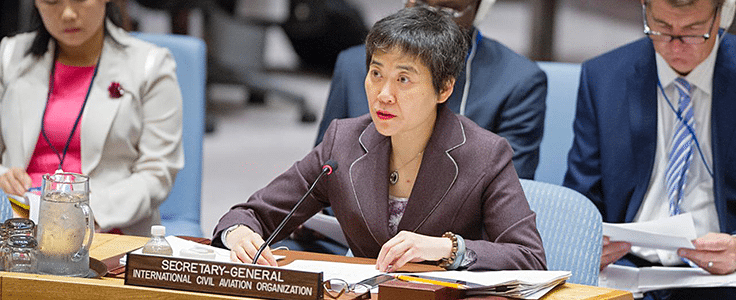
ICAO’s Dr. Fang Liu spoke on connectivity in China at the China Civil Aviation Development Forum
The International Civil Aviation Org. (ICAO) discussed the need for determined cooperation supporting international airspace safety and the importance of synergies challenges arising from international aviation and digital connectivity during two different missions recently. Dr. Olumuyiwa Benard Aliu, president of the ICAO Council, spread the word about safety in Ukraine, while the secretary general of ICAO, Dr. Fang Liu, talked connectivity while in China.
Aliu visited Ukraine with ICAO’s European and North Atlantic Regional Director Luis Fonseca de Almeida. They participated in bilateral meetings with several Ukrainian governmental leaders, where Aliu delivered his message. ICAO said discussions focused on its global role, and what it could provide to Ukraine under the No Country Left Behind initiative.
“This support is essential for states to effectively set out and adhere to ICAO’s global Standards and Policies, but it also requires substantial local political will and concrete commitments,” Aliu said. “Ukraine can count on ICAO’s assistance and capacity under our No Country Left Behind initiative to help it achieve these objectives, and thereby optimize air transport’s unique socio-economic benefits, and for our part ICAO will be counting on the Ukraine’s closer cooperation and support for our global and regional programs.”
He also encouraged the country to accelerate efforts toward the liberalization of its air transport sector and simplifying its visa process. ICAO, Aliu said, is currently reviewing associated regional concerns through its Black Sea Task Force.
Liu gave a presentation during the 2017 China Civil Aviation Development Forum, hosted by the Civil Aviation Authority of China (CAAC). The first session was, “New Opportunities for Aviation Development in the Internet Era”. There, she talked about e-commerce and the ever-growing need to transport large amounts of goods quickly. She also talked about the expanding middle class In Asia-Pacific, which has yielded many first-time flyers.
“These urbanization trends point to the need for greater integration of aviation and airport development and broader urban planning objectives,” Liu said. “Effective multi-modal solutions, for example, help to support faster-paced economic development, optimizing the use of infrastructure in otherwise low traffic airports, and promoting the economic potential of the less-developed areas to achieve more balanced regional growth.”
Because of these reasons, she continued, ICAO made efforts to incorporate civil aviation into the New Urban Agenda adopted last October by the UN Habitat III Conference. It is now also fostering joint activities with UN Habitat to effectively collaborate on how to link aviation and urban development.
ICAO hypothesized that in the next 20 years, Asia-Pacific air travelers will more than double to more than 5 billion. Liu noted that innovations like integrated system wide information management, air traffic flow management and airport collaborative decision-making should support that increase in areas of emissions, efficiency and safety.